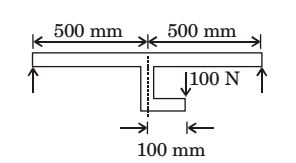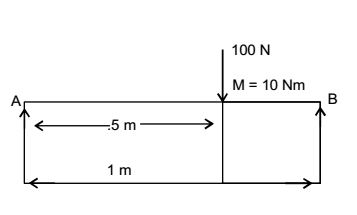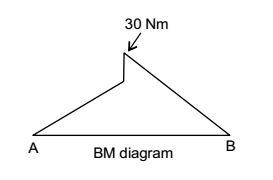Strength Of Materials Miscellaneous
- In a simply-supported beam loaded as shown below, the maximum bending moment in Nm is

-
View Hint View Answer Discuss in Forum

Taking moment about A,
100 × .5 + 10 = RB
RB = 60 N
∴ RA = 100 – 60 = 40N
Correct Option: B

Taking moment about A,
100 × .5 + 10 = RB
RB = 60 N
∴ RA = 100 – 60 = 40N
- A free bar of length/ is uniformly heated from 0°C to a temperature t°C, α is the coefficient of linear expansion and E the modulus of elasticity. The stress in the bar is
-
View Hint View Answer Discuss in Forum
For thermal stress to be developed there must be constraint in the system to oppose. So strain develops but there is no thermal stress.
Correct Option: C
For thermal stress to be developed there must be constraint in the system to oppose. So strain develops but there is no thermal stress.
- Determine the temperature rise necessary to induce buckling in a 1 m long circular rod of diameter 40 mm shown in the figure below. Assume the rod to be pinned at its ends and the coefficient of thermal expansion as 20 × 10–6/°C. Assume uniform heating of the bar.

-
View Hint View Answer Discuss in Forum

Let Bucking load be P
δl = αΔTL∴ ΔT = δl - (i) αL
We know:δl = PL ⇒ = AEδl - (ii) AE L Pcolumn = π²EI - (iii)[Both ends hinged] L²
Compare equation (ii) + (iii)AE δl = π²EI L L² Sl = π²l - (iv) LA
Putting the value of equation (iv) in equation (i)ΔT = π²I 
1 
= π²I LA αL L²Aα ΔT = π² × π × (0.040)4 64 1³ × π × (0.040)² × (20 × 10-6) 4
ΔT = 49.35°CCorrect Option: A

Let Bucking load be P
δl = αΔTL∴ ΔT = δl - (i) αL
We know:δl = PL ⇒ = AEδl - (ii) AE L Pcolumn = π²EI - (iii)[Both ends hinged] L²
Compare equation (ii) + (iii)AE δl = π²EI L L² Sl = π²l - (iv) LA
Putting the value of equation (iv) in equation (i)ΔT = π²I 
1 
= π²I LA αL L²Aα ΔT = π² × π × (0.040)4 64 1³ × π × (0.040)² × (20 × 10-6) 4
ΔT = 49.35°C
- A frame of two arms of equal length L is shown in the adjacent figure. The flexural rigidity of each arm of the frame is El. The vertical deflection at the point of application of load P is

-
View Hint View Answer Discuss in Forum
EI d2y = - Mx dx2
or Mx = – P (L–x)∴ EI d2y = P (L–x) dx2
Integrating two times and
puting x = L, we gety = PL3 3EI U = P2L3 + P2L3 = 4P2L3 2EI 6EI 6EI ∴ 1 × P × deflection = 4P2L3 2 6EI or Deflection = 4P2L3 6EI Correct Option: D
EI d2y = - Mx dx2
or Mx = – P (L–x)∴ EI d2y = P (L–x) dx2
Integrating two times and
puting x = L, we gety = PL3 3EI U = P2L3 + P2L3 = 4P2L3 2EI 6EI 6EI ∴ 1 × P × deflection = 4P2L3 2 6EI or Deflection = 4P2L3 6EI
- Two identical cantilever beams are supported as shown, with their free ends in contact through a rigid roller. After the load P is applied, the free ends will have

-
View Hint View Answer Discuss in Forum
As it is rigid roller deflection must be same because after deflection they also will be in contact but slope unequal.
Correct Option: A
As it is rigid roller deflection must be same because after deflection they also will be in contact but slope unequal.

